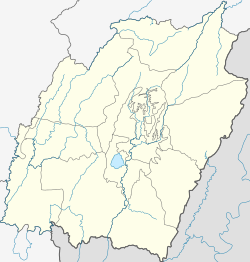Phumdi
| Phumdi | |
|---|---|
| Phumdis | |

Loktak Lake
|
|
| Location in Manipur, India | |
| Coordinates: 24°30′00″N 93°46′00″E / 24.50000°N 93.76667°ECoordinates: 24°30′00″N 93°46′00″E / 24.50000°N 93.76667°E | |
| Country |
|
| State | Manipur |
| District | Bishnupur District |
| Area | |
| • Total | 40 km2 (20 sq mi) |
| Elevation | 768.5 m (2,521.3 ft) |
| Languages | |
| • Official | Meitei (Manipuri) |
| Time zone | IST (UTC+5:30) |
| Vehicle registration | MN |
| Nearest city | Moirang, Imphal |
| Precipitation | 1,220 millimetres (48 in) |
| Avg. summer temperature | 32 °C (90 °F) |
| Avg. winter temperature | 4 °C (39 °F) |
Phumdis are a series of floating islands, exclusive to the Loktak Lake in Manipur state, in northeastern India. They cover a substantial part of the lake area and are heterogeneous masses of vegetation, soil and organic matter, in different stages of decay. The largest single mass of phumdi is in the southeastern part of the lake, covering an area of 40 km2 (15.4 sq mi). This mass constitutes the world’s largest floating park, named Keibul Lamjao National Park. The park was formed to preserve the endangered Eld's deer subspecies, called sangai in the Meitei language, indigenous to this area.
Phumdis are used by the local people for constructing their huts for fishing and other livelihood uses, and are inhabited by about 4000 people.Athapums are artificial circular phumdis, built by the villagers as enclosures for fish farming; aquaculture has caused proliferation of the phumdis in the lake.
Although phumdi vegetation has existed for centuries, it was not until 1886 that the Manipur Gazetteer recorded that wetlands with floating islands were used by inhabitants for fishing. Before the Itahi barrage was constructed in 1986, 207 khangpoks (huts or sheds) were reported on the phumdis, but after the dam was completed in 1999, the Loktak Development Authority (LDA) reported 800 such structures. Many of the huts are reported to have been converted into permanent dwellings and about 4,000 people live in these floating huts, earning their living as fishermen. The huts are constructed using plastic ropes, heavy rocks, wood, bamboo, zinc plates and iron rods.Athapums, artificial circular phumdis, which were built by the villagers as enclosures for fish farming, are present on the lake, and this aquaculture has caused further proliferation of the phumdis. A tourist lodge has been built on one of the phumdis in Sandra Island.
The floating mass of matted vegetation, organic debris, and soil that constitutes a phumdi has a thickness that varies from a few centimetres to two metres. Its humus is black in colour and porous, with a spongy texture. Only 20% of a phumdi's thickness floats above the water surface; the other 80% remains submerged. Before the construction of the Loktak Hydroelectric Project, the park area containing phumdis was merely marshy land, but since the commissioning of the project, two ecosystems have emerged. One, the body of open water, covers one-third of the area and the other, the phumdi, covers the remaining two-thirds.
...
Wikipedia


